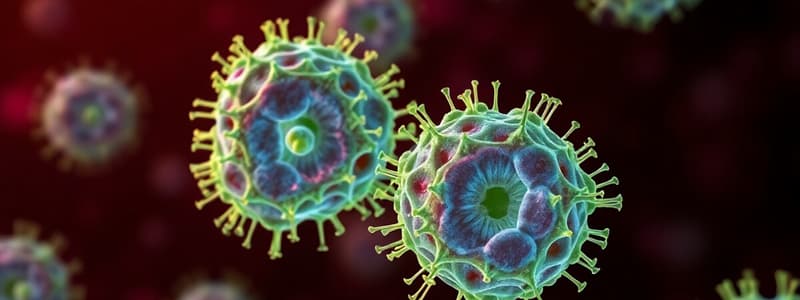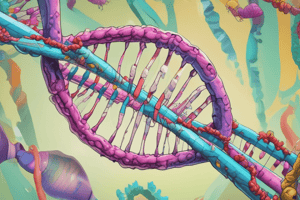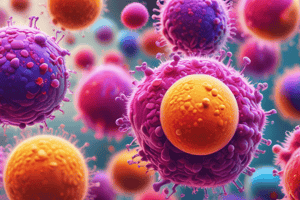Podcast
Questions and Answers
What is the consequence of a double positive thymocyte failing to bind to an MHC molecule during positive selection?
What is the consequence of a double positive thymocyte failing to bind to an MHC molecule during positive selection?
- Maturation into a gamma/delta T cell.
- Programmed cell death (apoptosis). (correct)
- Differentiation into a single positive CD4 T cell.
- Differentiation into a single positive CD8 T cell.
Which cell type presents self-antigens to thymocytes during negative selection in the medulla?
Which cell type presents self-antigens to thymocytes during negative selection in the medulla?
- Dendritic cells and macrophages. (correct)
- Single positive thymocytes.
- Double positive thymocytes.
- Cortical epithelial cells.
What is the primary purpose of negative selection in T cell development?
What is the primary purpose of negative selection in T cell development?
- To enhance the ability of T cells to bind to MHC class II molecules.
- To eliminate T cells that strongly react to self-antigens. (correct)
- To promote the differentiation of double positive thymocytes.
- To ensure T cells can effectively bind to foreign antigens.
Which of the following best describes the role of positive selection in T cell development?
Which of the following best describes the role of positive selection in T cell development?
What is the fate of double positive thymocytes that bind effectively to MHC class II molecules?
What is the fate of double positive thymocytes that bind effectively to MHC class II molecules?
Unlike alpha/beta T cells, how do gamma/delta T cells exit the thymus?
Unlike alpha/beta T cells, how do gamma/delta T cells exit the thymus?
Approximately what percentage of thymocytes die via apoptosis during T cell development?
Approximately what percentage of thymocytes die via apoptosis during T cell development?
What is the immunological consequence if T lymphocytes do not effectively learn to recognize "self" during T cell development?
What is the immunological consequence if T lymphocytes do not effectively learn to recognize "self" during T cell development?
Consider a hypothetical scenario where a developing thymocyte binds with moderate affinity to a self-antigen presented on MHC class I in the thymus. According to the principles of T cell selection, what is the most likely outcome for this thymocyte?
Consider a hypothetical scenario where a developing thymocyte binds with moderate affinity to a self-antigen presented on MHC class I in the thymus. According to the principles of T cell selection, what is the most likely outcome for this thymocyte?
A researcher introduces a mutation in mice that disrupts the expression of MHC class II molecules specifically in the thymic cortical epithelial cells. How would this mutation MOST DIRECTLY affect T cell development?
A researcher introduces a mutation in mice that disrupts the expression of MHC class II molecules specifically in the thymic cortical epithelial cells. How would this mutation MOST DIRECTLY affect T cell development?
Flashcards
Positive Selection
Positive Selection
Ensures circulating T cells recognize MHC molecules of the host body.
Thymocyte Binding Requirement
Thymocyte Binding Requirement
Double positive thymocytes must bind to self MHC molecules to avoid apoptosis.
Negative Selection
Negative Selection
Selects T cells with low affinity receptors for self-antigen, preventing autoimmunity.
Self-tolerance
Self-tolerance
Signup and view all the flashcards
T Lymphocyte Negative Selection
T Lymphocyte Negative Selection
Signup and view all the flashcards
Gamma/delta T cells
Gamma/delta T cells
Signup and view all the flashcards
Positive Selection Goal
Positive Selection Goal
Signup and view all the flashcards
Negative Selection Goal
Negative Selection Goal
Signup and view all the flashcards
Early T Cell Development
Early T Cell Development
Signup and view all the flashcards
Study Notes
- T cell recognition of self MHC molecules confirms T cells recognize host MHC molecules.
- The body selects immature T cells recognizing self MHC molecules on cortical epithelial cells in the thymus.
- This selection is vital for transitioning from innate to adaptive immunity.
- Failure of double positive thymocytes to bind to MHC or foreign antigen plus self MHC results in apoptosis.
Positive Selection
- Positive selection ensures only thymocytes that bind self MHC survive.
- It is the "first real exam" for thymocytes originating in bone marrow.
- Double negative thymocytes enter the subcaspular region of the thymus.
- Differentiation yields double positive thymocytes expressing CD4, CD8, and a TCR with CD3.
- Double positive thymocytes binding MHC class II receive a protective signal that prevents apoptosis and stops CD8 expression.
- These differentiate into single positive CD4 thymocytes.
- Double positive thymocytes binding MHC class I receive a protective signal and cease CD4 expression.
- They become single positive CD8 thymocytes.
- About 98% of thymocytes die via apoptosis in the thymus.
- The high death rate is due to eliminating thymocytes failing positive selection criteria.
Negative Selection
- Negative selection selects T cells with low affinity receptors for self-antigen.
- This is a checkpoint for self-tolerance, reducing autoimmunity.
- Thymocytes passing positive selection move to the medulla for negative selection.
- Thymocytes efficiently binding self peptides are potentially auto reactive and undergo apoptosis.
- Antigen presenting cells (APCs) like dendritic cells and macrophages in the cortical medullary junction present MHC class I or II with/without self peptides to single positive thymocytes.
- Thymocytes with high affinity receptors for self-antigen/MHC undergo apoptosis to ensure tolerance.
Importance of MHC Binding
- Thymocytes must bind with MHC complex proteins to function.
- CD8 cytotoxic T lymphocytes interact with MHC class I on infected cells.
- T helper cells interact with MHC class II on antigen presenting cells.
- T lymphocytes reacting with self undergo programmed cell death to prevent autoimmunity.
- Autoimmune disease can occur if MHC proteins do not effectively train T lymphocytes to recognize "self".
Thymocyte Populations and Gestation in Mice
- C3 is a marker for thymocytes.
- Delta/gamma T cells leave the thymus early in gestation without selection, providing innate immunity.
- Alpha/beta T cells undergo positive and negative selection, appearing later in gestation.
- Selection provides a subpopulation of helper T cells which transition immune response from innate to adaptive.
- They play a role in humoral and cellular immunity.
- Gamma/delta T cells are higher during early gestation.
- They are present in smaller quantities in adults compared to alpha/beta T cells.
Gamma/Delta T Cells
- They are prominent during early gestation and involved in early immune responses.
- Gamma/delta T cells play a role in protection from infections and tissue homeostasis.
- They are abundant in the fetal liver and thymus, moving to tissues/peripheral sites as gestation progresses.
- They are part of the innate immune system due to innate-like properties and a quick response.
- Gamma/delta T cells recognize stress signals/non-peptide antigens without adaptive immune activation.
- They produce cytokines and immune mediators upon recognizing stressed/infected cells.
Summary of Thymocyte Selection
- Alpha/beta lineage thymocytes undergo extensive selection.
- Double positive thymocytes undergo MHC restriction.
- Single positive thymocytes with high affinity receptors are eliminated for self-tolerance.
- Delta/gamma lineage exits the thymus without positive/negative selection.
Studying That Suits You
Use AI to generate personalized quizzes and flashcards to suit your learning preferences.




